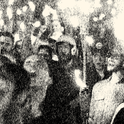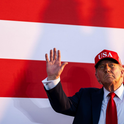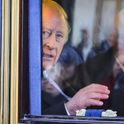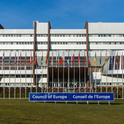As the seventh year of his presidency approaches, Barack Obama remains the most elusive figure in American politics. The contradictory signals he sends—of engagement and detachment, of passion and “cool,” of resolve and uncertainty—seem less mixed than self-obliterating. The presumed ditherer of late August—“We don’t have a strategy yet” for combatting Islamic State (the philosopher AC Grayling discusses this on p20)—stiffened, three weeks later, into a George W Bush-like “decider,” as he mobilised a sizeable alliance and ordered airstrikes in both Syria and Iraq. As the Washington Post reported, it was the start of “a military engagement that he acknowledged is likely to far outlive his time in office.” When pressed to concede, on the television programme 60 Minutes, that most of the actual fighting will be done by American forces, Obama brusquely cut the interviewer off. “America leads,” he said. “We are the indispensable nation”—the notorious coinage by Bill Clinton’s UN Ambassador (and later Secretary of State) Madeleine Albright in 1996, adopted since by Hillary Clinton, the Democrats’ most prominent hawk.
The irony was inescapable and, for his critics, a final indictment of Obama, or what he has become. To detractors on the left, Obama’s principles, if he ever had them, vanished long ago. Draping himself in the mantle of Bush’s war in Iraq—a war Obama forcefully opposed in 2002—is only the latest in a long list of cynical political moves. It includes the detainees still languishing in Guantánamo (Obama promised to shut the facility), increased drone attacks, secret campaigns in Somalia and Yemen, an attack on Syria and enlargement of the “surveillance state,” with its electronic dragnet flung over the citizenry.
To many entranced by him in 2008, Obama’s domestic policy has been no less disappointing. His economic advisors colluded with Wall Street while Obama himself bent to the Republican demand for reducing the public debt at the expense of jobless millions. Even his signal achievement in office, the Affordable Care Act, has failed to impress opponents on the left. As one such critic, Roger Hodge, wrote in his book The Mendacity of Hope: Barack Obama and the Betrayal of American Liberalism, Obamacare is a “Republican healthcare plan that does little more than tinker around the edges of the current failed system.”
Anti-Obama sentiment is, of course, even stronger on the right. It fills the pages of partisan books, magazines and newspapers, supplies an unbroken theme on cable news and talk radio, and furnishes punch lines for conservative politicians. Obama “has no idea how the American system functions, and we shouldn’t be surprised about that, because he spent his early years in Hawaii smoking something, spent the next set of years in Indonesia, another set of years in Indonesia, and, frankly, when he came to the United States he worked as a community organiser, which is a socialised structure.” This explanation came not from a conspiracist blogger but from John Sununu, the former Governor of New Hampshire and a co-chair of the Republican nominee Mitt Romney’s campaign in 2012.
The cost of all this is clear. In the run-up to the midterm elections on 4th November, Democrats have loped away from him. In close races, candidates made it clear an appearance by Obama would do more harm than good. He has “been reduced… to an isolated political figure who is viewed as a liability to Democrats in the very states where voters by the thousands had once stood to cheer him,” the New York Times reported on its front page a month before election day. Meanwhile, polls showed sinking confidence in his leadership at home and abroad. Since the two-term limit was imposed, in 1951, every president who has made it that far has instantly become a lame duck. But Obama has added new meaning to executive haplessness. He has seemed at times not merely frustrated, but a quizzical onlooker of his own presidency, curiously detached from the powers of the office. Faced with a stark either/or policy choice, Obama will slip into the role of “‘Professor-in-Chief,’ assessing all sides, and observing the tilt of the scales,” David Remnick, the Editor of the New Yorker and one of Obama’s biographers, wrote in January. If the byword this summer was “Obama fatigue,” the next two years are almost certain to be worse should Republicans gain a majority in the Senate in November, complementing their control of the House. The transformational and visionary presence of 2008 has all but vanished. Or so many now say.
The time has come, however, to consider something else: Obama is one of the most adroit politicians and effective statesmen in modern memory. He is, to begin with, one of only four presidents in the last 100 years (along with Franklin D Roosevelt, Dwight Eisenhower and Ronald Reagan) to have been elected more than once with over 50 per cent of the popular vote. Obama has done this, moreover, as the most unlikely president in history: a mixed-race Hawaiian with a “funny name” (his own words) whose formative years were spent outside the “lower 48 states.”
Then there are Obama’s economic policies, resisted at every step by Republicans and conservative writers, who have depicted his programme of recovery as a kind of trespass against the autarchic “free-market” creed sewn into the fabric of American liberty. In fact, the latest jobs report, released by the Labour Department in October, showed unemployment had dipped below 6 per cent for the first time since July 2008. This news sent the stock market surging toward a vertiginous peak. Problems remain. Many have dropped out of the labour force, and wages remain low—the results of an increasingly technology-driven global economy. But the recession has ended, and prospects are brightening. Even as “the dismal facts of median wage stagnation and soaring inequality… make this recovery far from ideal,” the commentator Andrew Sullivan observed in October, “an allegedly ‘socialist’ president has spawned a higher level of private sector job creation than the patron saint of private enterprise,” Ronald Reagan.
Throughout his time in office, there has been much parsing of the political skills Obama is said to lack, in particular his deficiencies at “retail politics”: the selling of programmes and policies to citizens; the courting of allies on Capitol Hill through backstage bargaining and arm-twisting; the rewarding of loyalists and punishing of foes. Critics cite the superior talents of Bill Clinton—the ebullient, voluble, indefatigable “schmoozer.” Yet Obama has managed to enact the most far-reaching legislation since the zenith of Lyndon Johnson’s Great Society. (Clinton’s attempt at healthcare reform—managed, or over-managed, by Hillary—was a fiasco.)
Obama might have accomplished even more, it is said, if he took more pleasure in the politics and were more attentive to the code of beltway bonhomie—pouring drinks and breaking bread with allies and foes. But this criticism is rooted in fantasy, or at least in mis-remembrance of politics past. Any number of presidents, including some of the most effective, have kept their distance from other politicians. Eisenhower, like Obama an avid golfer, preferred the company of businessmen and was contemptuous of legislators. Reagan exuded public warmth but was remote and unknowable even to those closest to him, including his own children, and left most of the deal-making to a highly disciplined staff, who often treated him like a figurehead. And like Obama, Reagan had a habit of snubbing loyalists. “In all these years, I’ve never asked but one thing of Ronnie,” Holmes Tuttle, one of Reagan’s long-time fundraisers, angrily recalled. “And that was for my wife and I to spend but one night in the Lincoln Bedroom… But I guess it slipped his mind.” (At last the invitation came—in the last month of Reagan’s second term. “I said no thanks. It’s too late,” Tuttle told a Reagan biographer.)
The predecessor whose style most parallels Obama’s—in its cool reserve, in the moat of self-protective irony he built—is John F Kennedy, who took office not quite seven months before Obama was born. Kennedy was also an outsider, the first (and still the only) Catholic ever elected president and, until Obama’s election 48 years later, the last Northern Democrat to win the office. “There was an elusive detachment to everything he did,” Norman Mailer observed of Kennedy at the Democratic nominating convention in 1960. He “seemed at times like a young professor whose manner was adequate for the classroom, but whose mind was off in some intricacy of the PhD thesis he was writing.”
Kennedy, too, chose the company of writers and historians, rather than that of other politicians. The scepticism he nursed—toward the presidency, his powers, and his followers—bordered on distrust. He was more distressed than elated by the enthusiasm of the crowds he stirred with his oratory, quite as Obama has stirred them, and by the fervid hopes he released in others. “Though he incited the euphoria, he did so involuntarily,” Kennedy’s advisor and chronicler Arthur Schlesinger Jr, wrote. “I never heard him now use the phrase [which had been part of his election campaign] ‘New Frontier,’” he recalled of Kennedy’s first months in office. “I think he regarded it with some embarrassment as a temporary capitulation to rhetoric.” Obama likewise has retreated from what he now calls the “aspirational” language of his 2004 speech at the Democrats’ national convention, with its summons “a politics of hope” (the title of a book Schlesinger published in the Kennedy era). Four years later, when Obama ran for president, the phrase was expanded to “hope and change.”
In one sense this was just the usual campaign drivel: uplifting and vacant. Yet the slogan reflected Obama’s singularity. The “aspirational” aspect of his candidacy spoke to two ideals: an end, at last, to long-standing political divisions and the final healing, perhaps, of America’s painful racial history. In truth, there was no exit from either, which meant Obama was doomed to fail and to disappoint those who took his message literally. But in American politics the concrete and the symbolic are not easily disentangled. The vaunting promises of presidents like Kennedy and Reagan were also unrealised, but over time they have acquired mythic meaning.
There is reason to believe Obama’s presidency has fulfilled at least some of its high ambitions. Today we take the idea of a black president for granted. But few did in February 2007, when Obama announced he would run. When he won his first contest, the Iowa caucus (the state is more than 90 per cent white), even adversaries sensed the possible cleansing of the nation’s darkest stain, slavery and its consequences: the Civil War, the aftermath of apartheid and second- class citizenship in Dixie, the persistence of “two societies, one black, one white—separate and unequal,” as a government report warned America was becoming in 1968, the year Martin Luther King Jr was assassinated and cities erupted in riots.
Forty years later, Obama showed political finesse in presenting himself in the fictive role of “post-racial” candidate. More than a century after the scholar W.E.B. Du Bois had described the “double consciousness” of being black in America—“this sense of always looking at one’s self through the eyes of others”—Obama added another layer, the further consciousness he gained through his mother and her Kansas parents, the white “half” of his heritage: he had an understanding of how racial differences looked to whites.
This was a theme in his memoir, Dreams From My Father, first titled “Journeys in Black and White” in the publisher’s contract—one of the handful of first-rate books written by any American president. And it was a theme in Obama’s memorable “race speech” in March 2008, when controversy engulfed his friend and religious mentor, the Reverend Jeremiah Wright, threatening to wreck Obama’s candidacy. At the time, the speech was much praised for its nuanced explication of black racial anxiety. But Obama spoke just as commandingly of what was once called “white backlash,” the resentment of whites who feared their own place in American society, economic and cultural, was being sacrificed to the demands of the civil rights movement. “Most working and middle-class white Americans don’t feel that they have been particularly privileged by their race,” Obama said.
Their experience is the immigrant experience—as far as they’re concerned, no one handed them anything. They built it from scratch. They’ve worked hard all their lives, many times only to see their jobs shipped overseas or their pensions dumped after a lifetime of labour… When they are told to bus their children to a school across town; when they hear an African-American is getting an advantage in landing a good job or a spot in a good college because of an injustice that they themselves never committed; when they’re told that their fears about crime in urban neighbourhoods are somehow prejudiced, resentment builds over time. It was such moments that gave historical depth and gravity to the election of 2008. “Obama made his biracial ancestry a metaphor for his ambition to create a broad coalition of support, to rally Americans behind a narrative of moral and political progress,” Remnick wrote in the afterglow of Obama’s first victory. “He was not its hero, but he just might be its culmination.”
No one really believed Obama could solve racial conflict. It is intrinsic to American politics and embedded in American history. And it didn’t take long for anti-Obama feeling to develop a racial tinge, whether through the whisper campaign that he is a Muslim or the demand that he produce his birth certificate. Things have improved since those early days, and yet whenever it seems Obama’s complex racial identity might ease tensions, it heightens them—for instance in August, when a policeman shot and killed an unarmed black teenager in Ferguson, Missouri, and violent protests ensued. Obama was accused by some of doing too little (not visiting Ferguson) even as others said he was doing too much (assigning the US Attorney General, Eric Holder, who is African American, to the case).
And yet Obama’s race has not been a handicap in his two elections, although many reflexively assume it has. As late as autumn 2012, commentators speculated whether his slipping support among whites might be ruinous. “Could Obama’s struggles with white voters cost him the election?” CNN wondered two weeks before election day. In fact, he has fared as well, or as poorly, with white voters as other recent Democrats: the 43 per cent of the white vote he got in 2008 was as much as any Democrat has achieved since Jimmy Carter’s 47 per cent in 1976. And although Obama’s share of the white vote dipped to 39 per cent in 2012, Bill Clinton received the exact same share of the white vote in 1992. Moreover, Carter and Clinton are both southerners, white “native sons” of the region where racial lines are drawn most bluntly.
The difference between the Clinton and Obama eras is that the “two nations” are no longer white and black, but rather white and “other,” and the size of the second group is growing. As recently as 1992, the electorate was 88 per cent white. The “New Democrat” Bill Clinton expended great effort trying to soothe its hidden injuries in his odes to the middle and working classes, the “forgotten man,” the overlooked Everyman or Average Citizen who “worked hard and played by the rules” but felt abandoned by a Democratic Party “preoccupied with the needs of minorities” and that “no longer responded with genuine feeling to the vulnerabilities of the average middle-class person,” as the pollster Stanley Greenberg reported after conducting surveys and “focus groups” with alienated white voters.
The America of 1992 already seems a distant place. In 2012, the non-white percentage of the vote had doubled, and Obama easily captured not only the black vote, but also the Hispanic and Asian and Pacific Island votes. Together those groups are the foundation of a new majority. Within 30 years, thanks to immigration and intermarriage, most Americans will be non-white. Among the rising generation of “millennials,” the giant cohort born after 1980, an estimated 43 per cent are non-white. It is this transformation that Obama personifies and whose tribune he still is. And Republicans know it. That is why the party, after the thrashing Mitt Romney received from non-white voters in 2012, is trying to burnish its image, by promoting the candidacies of the Hispanics Ted Cruz and Marco Rubio, and the south Asian Bobby Jindal. A generation ago conservatives mocked “identity politics” and “multiculturalism.” Today they are fashioning their own version of it, sometimes desperately, for fear of being written off as “the party of white people.”
In addition to the racial promise Obama offered another, corollary one. This was the idea that the insistent splitting of the American political atom into fissionable “red” and “blue” constituencies might be transcended—that it was, perhaps, already outmoded, the legacy of the Clinton and Bush presidencies. Instead of running against the unpopular departed Bush, and offering a return to Clintonism, Obama lumped his two predecessors together and suggested there was a new way. As he was “post-racial,” so Obama was also “post-partisan,” exciting even jaded party professionals with the prospect that he “could move the country past the bitter polarisation of the previous 15 years,” as John Heilemann and Mark Halperin reported in Game Change, their insider account of the 2008 campaign.
But if Obama has fulfilled at least some of the hopes invested in him as America’s first black president, the second promise he embodied, the ideal of a “post-partisan” politics, looks more remote than ever. In fact, the term is misleading, an awkward updating of bi-partisanship, the consensus rooted in a time when liberals and conservatives could be found in both parties and coalitions could be cobbled together across party lines. A liberal Democratic president like Roosevelt or Johnson often had the support of liberal Northeastern Republicans, and a conservative Republican president like Reagan relied on conservative Southern Democrats. These specimens are all but extinct, save in the tiniest numbers huddled on the fringes of American politics.
Democrats looking for rescue always turn to the example of Roosevelt. Swept into office during the Great Depression, he promised deliverance and made good on much of it. Initially, it seemed, Obama’s presidency might have the same momentum. Shortly after his election in 2008, Time magazine showed him on its cover—Obama in FDR-style dove-coloured Fedora, rimless pince-nez, and shark’s toothy grin, with the headline “The New New Deal.”
But the comparison was inapt. In 1933 the depression was in its fourth year. The country was exhausted, in search of any exit. There was opposition to the New Deal, and cries of “bolshevism,” but there was, at first, no organised counter-movement. Obama’s situation was different. In 2009, the crisis was just beginning. The banking collapse was only a few months old. The economy was in free-fall, haemorrhaging jobs at a rate of 800,000 a month. Obama acted boldly. His $80bn bailout of the Detroit car industry, greeted sceptically, worked. And Obama’s economic stimulus quite possibly pulled the country back from the brink of a second Great Depression. It was also a major legislative feat. Its $787bn equalled about 4 per cent of Gross Domestic Product, more than double what Roosevelt managed in any single year.
As late as 2010, Eric Cantor, a rising power in the House (but since defeated in the 2014 Republican primary), maintained that Obama’s policies were not only ineffective but a kind of boondoggle. Obama and the Democrats were exploiting “a phony ‘crisis’ cooked up to sell the public on [Washington’s] latest big government scheme.” In other words, a high Republican official was not ready to concede the reality of economic crisis. This was not a partisan difference but an ideological one, and it has been reflected in every debate of the Obama years, not only over taxes and spending, but also the extension of unemployment benefits, the building of new roads, reform of gun-control and healthcare policy.
This, too, is a phenomenon with deep roots. “We have to begin with an observable thing we can call a constant in American history—the fear of government, sometimes sensible, sometimes hysterical, but always pronounced,” Garry Wills, the historian and writer, pointed out in 1999, in the last year of Clinton’s presidency. It was a time of insurgent furies (militia groups, the Oklahoma City bombing) far fiercer than any loosed in the Obama years.
The rejection of Obamacare is one expression of this fear of government. States are not obliged to enact all features of the programme and 22 states—mostly those in the south, the plains and the west; Republican strongholds—have rejected the “Medicaid expansion,” depriving nearly six million of the country’s neediest citizens of $400bn or more in federal coverage.
In Kentucky, a poor state in which more than 600,000 people lacked coverage, the percentage of the uninsured has since been sliced nearly in half. Yet Kentucky is a hotbed of anti-Obama feeling. Mitch McConnell, the Kentuckian poised to become the Senate majority leader if the Republicans win in November, has said he may threaten another government shutdown if Obama doesn’t agree to cut the budget on GOP terms. Kentucky’s other senator, Rand Paul, a libertarian who most expect will seek the presidential nomination in 2016, continues to call for the healthcare law to be repealed and has himself proposed a budget that would shred federal programmes. This dissonance between economic fact and ideological dream was most memorably expressed in 2009, when an anguished older voter at a “town hall meeting” warned his House representative: “Keep your government hands off my Medicare.” The representative, Bob Inglis, a Republican stalwart first elected to the House in the 1990s, replied, “Actually, sir, your healthcare is being provided by the government.” Inglis was subsequently thrashed by a Republican challenger in the Tea Party insurgency of 2010 and said at the time that the GOP had moved so far to the right that even Reagan would no longer be welcome in it.
“T he compromiser, the reconciler… began by believing he could unify the country,” a columnist wrote of the president. “Yet in his years in the White House the differences—the differences that transcend the conventional political boundaries—have if anything been accentuated.” The columnist was Marquis Childs, writing in 1958, and the president was Eisenhower, about to begin his last two years in office.
Eisenhower had advantages Obama lacked. He was re-elected in a large landslide. He won 57 per cent of the vote and carried 41 states. He was also a war hero—“the soldier of democracy”—and a centrist Republican. It would seem a formula for many successes. Instead there was continual struggle. Like his Democratic predecessors he met resistance from conservative legislators, mainly Midwestern Republicans and Southern Democrats. Repeatedly, isolationists in the Senate tried to strip him of even routine treaty-making authority, and nearly succeeded in 1954. Meanwhile, there was an insurrection from the Republican Joseph McCarthy, who bedevilled Eisenhower’s first term and for a time commanded a rival national following.
Obama has something important in common with Eisenhower: the majority of the public agrees with him on the big issues of the day. In the 1950s, most Americans supported Eisenhower’s modest expansion of the welfare state, just as most Americans today favour a more generous minimum wage and think the rich should pay more in taxes. In the 1950s, most Americans supported Eisenhower’s mild opposition to Jim Crow laws, just as most today support marriage equality.
But majority support doesn’t translate into presidential license to enact it. To suppose otherwise is to subscribe to the fiction or fallacy of the presidential “mandate,” which has no basis in the US constitutional system. On the contrary, its machinery of checks and balances puts the “chief executive” in charge of only one of the three branches of the federal government, and in many areas leaves him, for all the celebrity and ceremonial lustre that comes with the office, at the mercy of both the legislature and the judiciary.
The presidential mandate has “been engrafted on our political system,” the political scientist Willmoore Kendall pointed out in 1960. “It was not intended by the [constitution’s] framers, not even present to their minds as something to be ‘frustrated’ and have ‘barriers’ put in its way.” The system was designed to do the opposite, to “make it possible for little bands of wilful men” to stop the president at almost every turn. The principle behind it was majoritarian, Kendall argued, but it was rooted in congressional, not presidential, supremacy; in the ideal of the locally elected official directly accountable to his constituents (every two years in the case of the House) and to discussion in which “the participants… are not so numerous as to give scope to the gifts of the orator and the rhetorician.”
To read Kendall in 2014 is to be surprised by how little the contentious battles have changed. Though himself very much on the right, he acutely captured the exasperation of liberals and “the intellectual community,” for whom the Tea Party, most conspicuously, now represents an outburst of irrationality. Kendall’s list of political disputes is almost identical to those of the present moment—over taxes, civil rights, “the welfare state” versus “capitalist society,” diplomacy versus unilateralism in foreign policy, even on “science and the ‘scientific outlook.’”
One change is that when Kendall was writing, the liberal orthodoxy was more widespread. There was only one influential conservative magazine (William F Buckley’s National Review). The conservative “counter-establishment” had yet to form. Today, it is a potent force, but speaks only to its own. The same is true, however, of the liberal media. During the government shutdown of 2013, to cite one instance, it offered a great deal of commentary on “rogue” House Republicans, explaining that they could afford to risk the wrath of the country because they came from gerrymandered districts and so could count on being re-elected. But much less could be found on the constituents who had elected the rogues and now stood with them—indeed had elected them to do just what they did.
Kendall argued that there were “two majorities”—the one that elected the president, and the other that chose its representatives on Capitol Hill. He really meant there are two Americas. Obama knows this too. And this accounts, in large part, for his detachment and reserve. The author of the great race speech understands how strongly the “other side” feels. And the former constitutional lawyer knows how many obstacles block his progress. It is our ideal of the president as culture hero as well as political leader that makes us think a single person can remake the nation. Obama has come as close as anyone in the modern era. America has become a different place, and for millions of its citizens a more tolerant one, thanks in large part to Obama. Like Roosevelt and Reagan, he has altered the country’s sense of itself. And that is the definition of a transformational presidency.

Has Obama really made the world safer? © JIM WATSON/AFP/Getty Images
In defence of Obama
The US President is one of the most effective statesmen in modern American history
October 15, 2014











